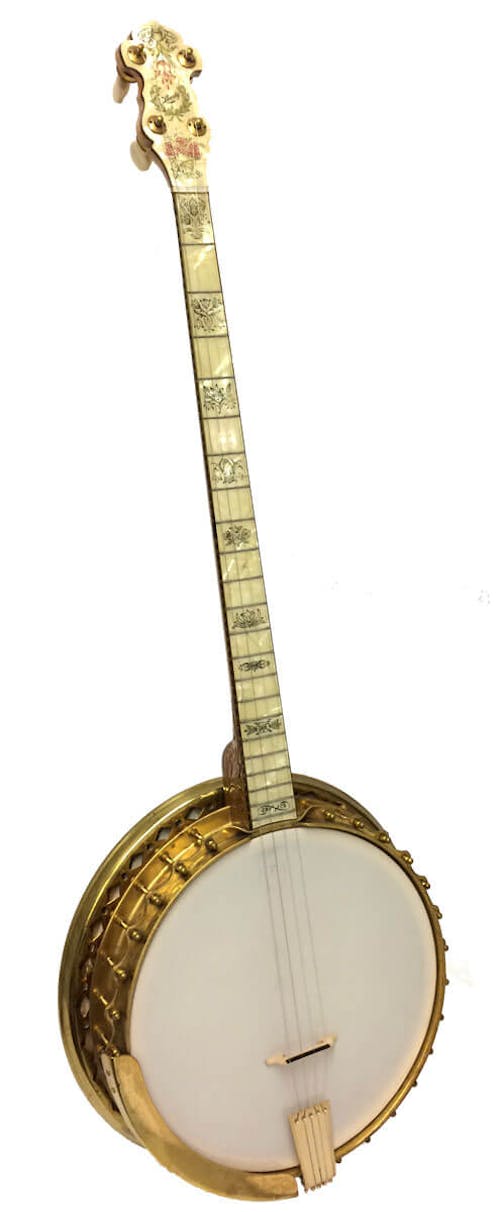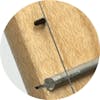


Leedy Solotone Plectrum Banjo and Hard Shell case - Commission Sale **SOLD**
Fast Delivery
We can delivery any product worldwide, when checking out, the type of delivery services available may change based upon your location and items in your basket, in some cases you may be offered a choice of delivery methods to choose from at differing costs.
We have made every effort to ensure our delivery costs are as competitive and fair as possible.
Dependant upon stock availability and time of purchase, we endeavour to ensure that orders are speedily processed and despatched the same day. We provide an estimated delivery date as seen above, if your order contains multiple items, the estimated delivery date may be updated during checkout.
Musical instruments that are given our free instrument setup will be despatched within 1-2 days using. In the UK, most musical instruments will be sent by DHL, smaller items such as books and accessories maybe be sent by Royal Mail.
Save on these quality 5 string banjo accessories
Description
This particular Leedy Solotone was last owned and played by Bob Rogers. A well respected session musician who played for many years with acts like The Ted Taylor Four, Adam Faith,Freddie and the Dreamers and in later life was part of the much loved 'Skinnerettes..Frank Skinners TV backing band.
Features
- Gold plated rim -
- 28 rim bolts - top tension style
- Pearloid faced fingerboard with detailed wood binding
- Bone nut
- Pearloid faced headstock
- Pearloid faced heel plate
- Pearloid back of resonator
- Gold rear facing geared tuners with pearloid buttons
- 2 Footed maple/ebony bridge
- White smooth top head
- Gold plated adjustable armrest
- Gold plated Kershner style taipiece
Tuning: DGBE but can be tuned standard plectrum CGBD or other tunings
Finish: Natural Gloss finish
Case/Gig Bag: Original fitted case
Set-Up: Each banjo we supply is individually set up in our on-site Specialist Workshop here at Eagle Music. Any banjo purchased from Eagle will be fully SET UP, checked for intonation and playability and tuned ready for playing straight out of the box!
Information about Leedy Banjos and the Solotone
The Leedy Drum Company was founded in 1898 in Indianapolis, and it remained a highly successful operation for several decades. By the mid 1920s, the company’s leadership noticed the huge popularity of the tenor and plectrum banjo among contemporary jazz ensembles. Along with other drum makers such as Slingerland and Ludwig, Leedy spent massive amounts of capital tooling up to build banjos. Unfortunately, Leedy got on board the banjo train shortly before the instrument’s popularity started to wane, and the company was unable to recoup the money it spent on tooling. The company was in dire financial straits by 1929, when it was sold to the Conn company. Conn also purchased Ludwig shortly after, and within a few years it had discontinued the banjo lines of both brands.
Unlike most other builders of the day, the models in Leedy’s banjo line were nearly all the same in terms of construction. The lowest-level models, which were not cheap, employed the same methods of construction as the highest-level ones. The walnut rim was encased in a brass outer shell that doubled as the tone ring. The hoop was attached with a top-tension system. It allowed the head to be adjusted without removing the resonator. In the days when skin heads were the norm, this allowed players to make frequent adjustments on the fly.
The history of Leedy banjos is as difficult to piece together as it is short. It appears that the company introduced its first banjos – the Solo Tone line – in 1924 or 1925. These were fairly traditionally decorated with pearl inlays in ebony fretboards and headstocks. The brass rims and hoops were engraved; some were plated in nickel or gold, but some were left unplated depending on the model. A few rims were finished in black. Resonators were sometimes left as bare wood (usually walnut to match the necks) or, probably later, covered with pyralin veneers. The highest-end models featured carved heels.
Advertisements from mid 1926 announced a new line of Leedy banjos, to which my Amphion belongs. These new models featured the same construction and most of the same hardware as the Solo-Tones (which appear to have been discontinued around this point) but the decoration was largely revamped. The new lineup made extensive use of plastic veneers, some with pearloid finishes and some with embedded sparkles. Most of these plastic surfaces showed some degree of engraved decoration, darkened with ink to make it visible. The expensive “National” line (including the Egyptian, Grecian and Hollander models) had resonator engravings and heel carvings depicting stereotypical scenes from their namesake countries.
Specification
Banjo Type | 5 String Banjo |
|---|---|
Number of Strings | 5 String |
Other
Right or Left Handed | Right Handed |
|---|
Used Status
Availability | SOLD |
|---|---|
Used Instrument | Used |
Customers who bought this item also showed interest in
Popular banjo accessories
Eagle Music has become the go-to destination for banjo accessories, our expertise and fantastic range ensures you'll always have the best accessories to compliment your banjo. From thumb picks to tuners, strings to tutor books, we have it all at Eagle Music Shop.


